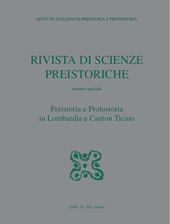Agricoltura e preferenze alimentari durante le età del Bronzo e del Ferro in Lombardia
P. 63-73
Despite the large number of Bronze and Iron Age sites in Lombardy, the available archaeobotanical data are rather poor and discontinuous. The analysis of plant remains preserved in archaeological deposits is still too occasional in Italy and it does not fall into the standard practice of archaeological investigations, although this discipline has gained in recent years much more interest and attention. Usefully, the Bronze Age is documented in Lombardy by a significant array of lacustrine and fluvial settlements where the waterlogged archaeological layers favoured the preservation of plant remains, even not charred. Some of these sites have been the subject of recent multidisciplinary investigations including detailed archaeobotanical ones. This resulted in the identification of new cultivars (e.g. Carthamus tinctorius) and allowed a closer appreciation of the broad spectrum of cultivated crops, particularly cereals.
Furthermore, it stressed the importance of some cereal crops, such as the ‘new glume wheat' (Triticum nn or T. cf timopheevii), which was introduced in Italy in the Neolithic period and gained considerable importance in the Bronze Age. During the Middle Bronze Age, broomcorn millet (Panicum miliaceum) is a well-established crop and pulses acquire greater importance, despite they are still poorly represented in the carpological record. Iron Age sites yielded only carbonized plant materials. Broomcorn millet and foxtail millet (Setaria italica) are the dominant cereal crops.
Either naked wheat or hulled wheat (emmer and einkorn) are abundant at some sites; barley is frequent but not particularly abundant. Spelt and rye appear at some sites as an established crop. Horse bean, lentil, and bitter vetch remarkably increase their presence/frequency in this period confirming the trend towards an increase in pulse cultivation started in the Middle Bronze Age, when these species, even if already present, were never abundant. [Publisher's text]
-
Articoli dello stesso fascicolo (disponibili singolarmente)
-
Informazioni
Codice DOI: 10.32097/1164
ISSN: 2282-457X


